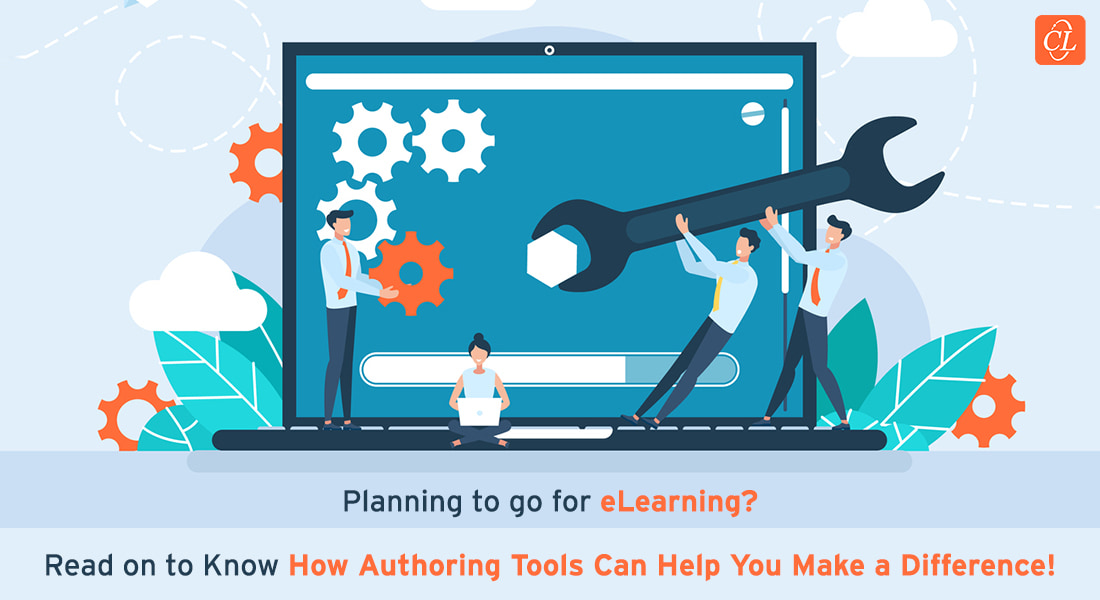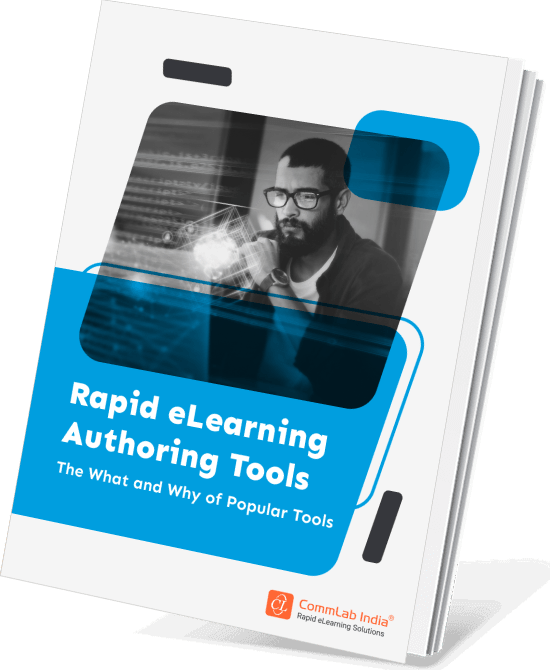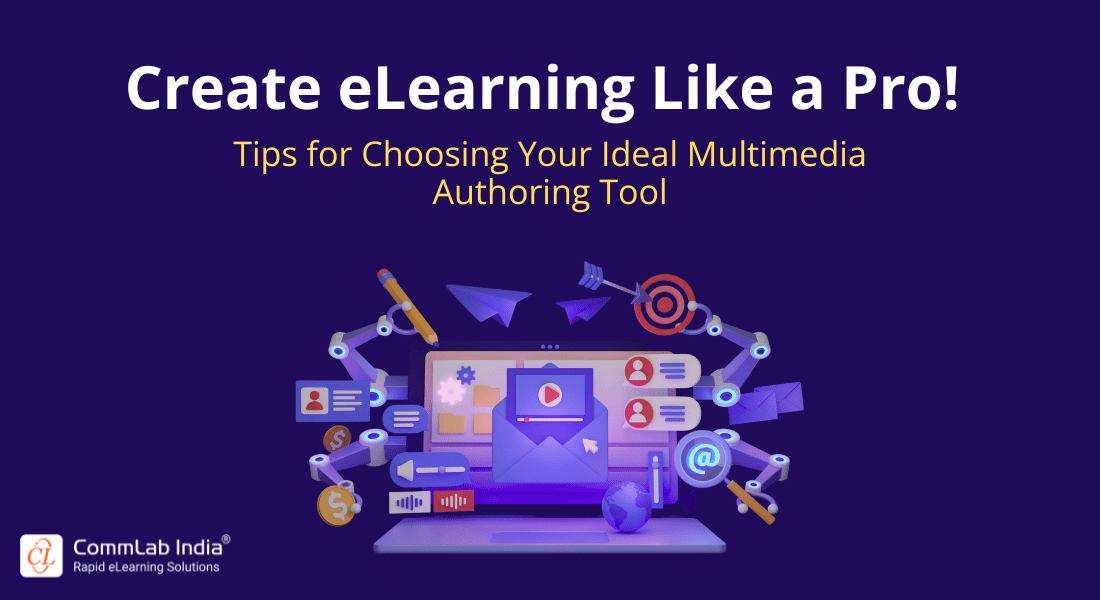How eLearning Authoring Tools Can Benefit Your Organization

In 2016, Statista Research Department suggested that the use of eLearning authoring tools was at an all-time high and that the industry would only see a decline moving forwards. The same forecast suggested that by 2021, the market would stand just at $22.60 billion. However, Coronavirus changed everything, and now, in 2022, the eLearning revenue is expected to go well beyond $55.69 billion by the end of 2022, with a CAGR or 2.61% till 2027.
This is not just limited to educational institutions, but also extends to organizations as well. eLearning has found roots in skill development, microlearning, organizational training, personal improvement, and so much more over the years.
Having the Right Authoring Tool is Essential for a Smooth eLearning Course Development
The perfect authoring tool for developing eLearning should assist you in:
- Reduced eLearning development time
- Improved eLearning course update time
- Enhanced engagement
- Improved publishing and revision process for programs and courses with respect to relevant learning and subject standards.
With eLearning tools being so popular, organizations not only have an opportunity to help spread knowledge more effectively, but they can also improve their revenue prospects exponentially. Currently, the average revenue per user (ARPU) for eLearning tools stands at $82.05, and is expected to rise in the coming years as user penetration rises from 9% in 2022 to 11.4% in 2027.
In this article, we will go over how eLearning development can be a key investment on your part, and why authoring tools for development is so important.
Importance of Authoring Tools for eLearning Development
Authoring tools are important for eLearning development as they provide a way to create engaging and interactive content. They also allow for the creation of customized eLearning experiences, which can be tailored to the needs of specific learners, hence improving revenue generating capabilities.
There is a range of different authoring tools available, each with its own advantages and disadvantages. It is important to select the right tool for the task at hand, as well as for the specific needs of the learners.
For Rapid eLearning Development, Check Out Our One-Stop Guide to eLearning Authoring Tools.
Three of the most popular authoring tools include:
1. Adobe Captivate
A powerful tool for creating rich media content, Adobe Captivate is commonly used for creating simulations, screencasts, and other types of interactive content. It is one of the most extensive and powerful authoring tools for eLearning development.
2. Articulate Storyline
A popular choice for creating story-based eLearning content, Articulate Storyline allows for the creation of highly interactive and engaging courses (with interaction being the primary selling point of the development tool).
3. Lectora Inspire
Another tool commonly used for creating story-based eLearning content, Lectora Inspire also allows for the creation of customized eLearning experiences. It boasts a dynamic range of eLearning development tools, including Camtasia, BranchTrack, eLB assets, and more.
Other eLearning authoring tools include:
- Elucidat
- Gomo
- Adapt
- iSpring Suite
- Evolve
Each of these authoring tools has its own unique features and benefits, so it is important to select the right tool for the specific needs of the project.
When selecting an authoring tool, it is also important to consider the level of experience of the team using it. Some tools may be more suited to experienced developers, while others may be more user-friendly for those with less experience.
Considerations for the Best Authoring Tools for eLearning Development
When you’re looking for eLearning development tools, it’s important to choose ones that will help you create content that is both engaging and interactive. The best tools will allow you to create customized eLearning experiences that are tailored to the needs of your specific learners.
General Considerations
Some of the things you should look for in eLearning development tools include the ability to:
Create rich media content
Rich media content is important for creating engaging and interactive eLearning courses. Look for tools that allow you to easily create simulations, screencasts, and other types of rich media content.
Create customized eLearning experiences
Customization is key when it comes to creating eLearning courses that are tailored to the needs of your specific learners. Look for tools that allow you to easily personalize the learning experience for each learner. Branding plays an important role in offering personalization to the learners. Choose those authoring tools that can help in creating a GUI (Graphic User Interface) that resonates your company’s branding by integrating elements like brand colors and specific font style.
Create engaging and interactive content
Engaging and interactive content is essential for keeping learners engaged in the learning process. Look for tools that allow you to easily create interactive quizzes, games, and other types of content that will keep learners engaged.
Track learner progress
Tracking learner progress is important for ensuring that courses are effective. Look for tools that allow you to easily track how learners are progressing through the course and identify areas where they may need more help.
For developers, technological prowess is key to ensuring your eLearning development process is in your favor. The right authoring tool for eLearning development should ideally help you:
- Reduce eLearning development time
- Improve eLearning course update time
- Improve engagement
- Improve publishing and revision process for programs and courses with respect to relevant learning and subject standards.

Rapid eLearning Authoring Tools
Explore the What and the Why of Popular Rapid eLearning Development Tools, and GenAI Tools
- Categories of eLearning Authoring Tools
- Considerations to Choose Your Next Authoring Tool
- Features of Popular Rapid Authoring Tools
- GenAI Tools to Create Content, Graphics, Audio, and Video
Functional Considerations
You need to consider the needs of your specific learners. What type of content do they need? What type of learning experience do you want to create? It is important to consider their needs to understand the best mode of delivery.
Next, you should consider the features and capabilities of the different authoring tools. Adobe Captivate, for instance, allows you to dive much deeper into every element than any other authorizing tool. Articulate, on the other hand, is an all-time favorite for people who have an interactive audience, such as children and teenagers.
Lectora offers more of a “lecture” type eLearning development experience, while adapt offers all-round tools – but not in that much depth. Of course, this means that making major amendments or overhauls in Adapt and Articulate is also easier and quicker than in Adobe Captivate.
You need to consider which one offers the best combination of features and ease of use that meet your style and allows you to shape your course according to the audience efficiently.
Finally, you should consider the cost of the different authoring tools. Some authoring tools are free to use, while others can be quite expensive. Choose the authoring tool that fits your budget and your needs. Adobe Captivate, for instance, costs $33.99 per month, while Articulate costs $1,099 for individuals and $1,399 for teams (per annum).
Choosing the right eLearning development tools is essential for creating successful eLearning courses. By selecting tools that meet the needs of your specific learners, you can ensure that your courses are engaging, interactive, and the development process is efficient.
Advantages of Authoring Tools for eLearning Development to Your Business
There are a number of advantages that authoring tools for eLearning development can offer to your business. Authoring tools can help you:
Save Time
Authoring tools can help you save time by allowing you to quickly create and update eLearning courses.
Improve Engagement
Authoring tools can help you create more engaging and interactive eLearning courses that keep learners engaged in the learning process.
Enhance Course Quality
The right tools can help you create higher-quality eLearning courses by providing you with more features and capabilities.
Reduce Costs
With these tools, you can reduce the cost of eLearning development by reducing the time and efforts included in eLearning development.
Improve Collaboration
Authoring Tools can improve collaboration by allowing different team members to work on the same project at the same time.
Customize Learning Opportunities
They can help you customize learning opportunities by allowing you to create courses the way you want.
Become a Subject Matter Expert
Authoring Tools can help you become a subject matter expert by allowing you to create courses that focus on your area of expertise.
Bottom Line
Authoring tools can offer a number of advantages to businesses that want to create eLearning courses. Not only do they help you save time, improve engagement, increase course quality, but ultimately, the right authoring tool for eLearning development can also help you reduce costs and improve revenue potential. However, it is important to choose the right authoring tool for your needs in order to get the most out of your investment. For more insight download this free eBook now.





